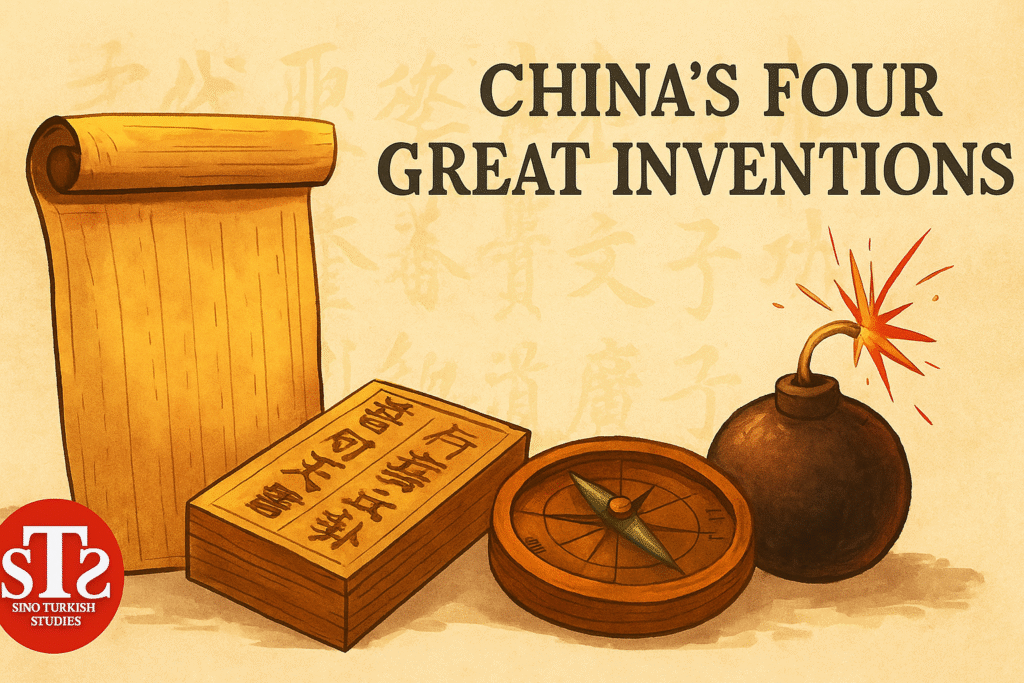Paper, printing, compass, and gunpowder. These four groundbreaking innovations are not only milestones of Chinese civilization but also turning points in the history of human progress. The term “China’s Four Great Inventions” (Chinese: 中国四大发明) refers to the most significant technological contributions of ancient China to the world. But when did this concept emerge, and how did these inventions transform global development?
The Origin of the “Four Great Inventions” Concept
The term “Four Great Inventions” did not originate in ancient China, but was coined in the early 20th century by Chinese scholars. It became a symbol of national pride and scientific heritage. The British science historian Joseph Needham played a crucial role in popularizing the concept worldwide through his extensive research on the history of Chinese science and technology.
1. Paper (纸)
- Invention Date: 2nd century BCE, systematized by Cai Lun in 105 CE
- Importance: Replaced costly materials like silk and bamboo with a cheap, efficient medium for writing
- Impact: Enabled mass literacy, record-keeping, and administrative growth; facilitated cultural transmission throughout East and West Asia, and later Europe
2. Printing (印刷术)
- Invention Date: Woodblock printing during the Tang Dynasty (7th century); movable type invented by Bi Sheng in the 11th century
- Importance: Allowed the mass reproduction of texts and dissemination of knowledge
- Impact: Preceded Gutenberg’s press by 400 years; empowered education and scholarship in pre-modern societies
3. Compass (指南针)
- Invention Date: Magnetic stones used as early as the Han Dynasty; fully developed navigational compasses appeared during the Song Dynasty (11th century)
- Importance: Made reliable navigation possible on land and at sea
- Impact: Played a pivotal role in global exploration and maritime trade; helped shape the Age of Discovery
4. Gunpowder (火药)
- Invention Date: Discovered by Taoist alchemists during the Tang Dynasty
- Importance: First used in rituals and fireworks, later revolutionized warfare
- Impact: Triggered major changes in military technology, leading to the development of guns, cannons, and modern warfare strategies
Why These Four?
While ancient China produced numerous inventions—from the seismograph to paper money—these four are considered “great” because of their global and long-lasting influence. They reshaped human communication, mobility, military power, and intellectual development.
Conclusion
China’s Four Great Inventions represent more than just technological advancements—they are a testament to the ingenuity and enduring impact of ancient civilizations. Even today, our world continues to benefit from these innovations in education, communication, travel, and security. Understanding their origins helps us appreciate the global legacy of Chinese science.
✅ Meta Description
Discover the history and global impact of China’s Four Great Inventions: paper, printing, compass, and gunpowder. A legacy that changed the world.
🔑 Keywords
- Four Great Inventions of China
- ancient Chinese inventions
- history of paper invention
- movable type printing China
- invention of the compass
- gunpowder origin
- Joseph Needham China
- Chinese scientific contributions
- history of Chinese technology
- China civilization achievements
Abroad Africa AI Beijing Belt & Road BLCU BRICS China chinese CPC CSC Culture Economy education EU Guizhou Kültür Langauge movie Multipolarity Russia scholarship science Shanghai Sino Sino Turkish Sino Turkish Sino Turkish Sino Turkish Sino Turkish Studies Sino Turkish Studies Sino Turkish Studies Sino Turkish Studies space Syria Taiwan Tariff trump Turkiye Türkiye University USA Xinjiang ZJUT Çin





